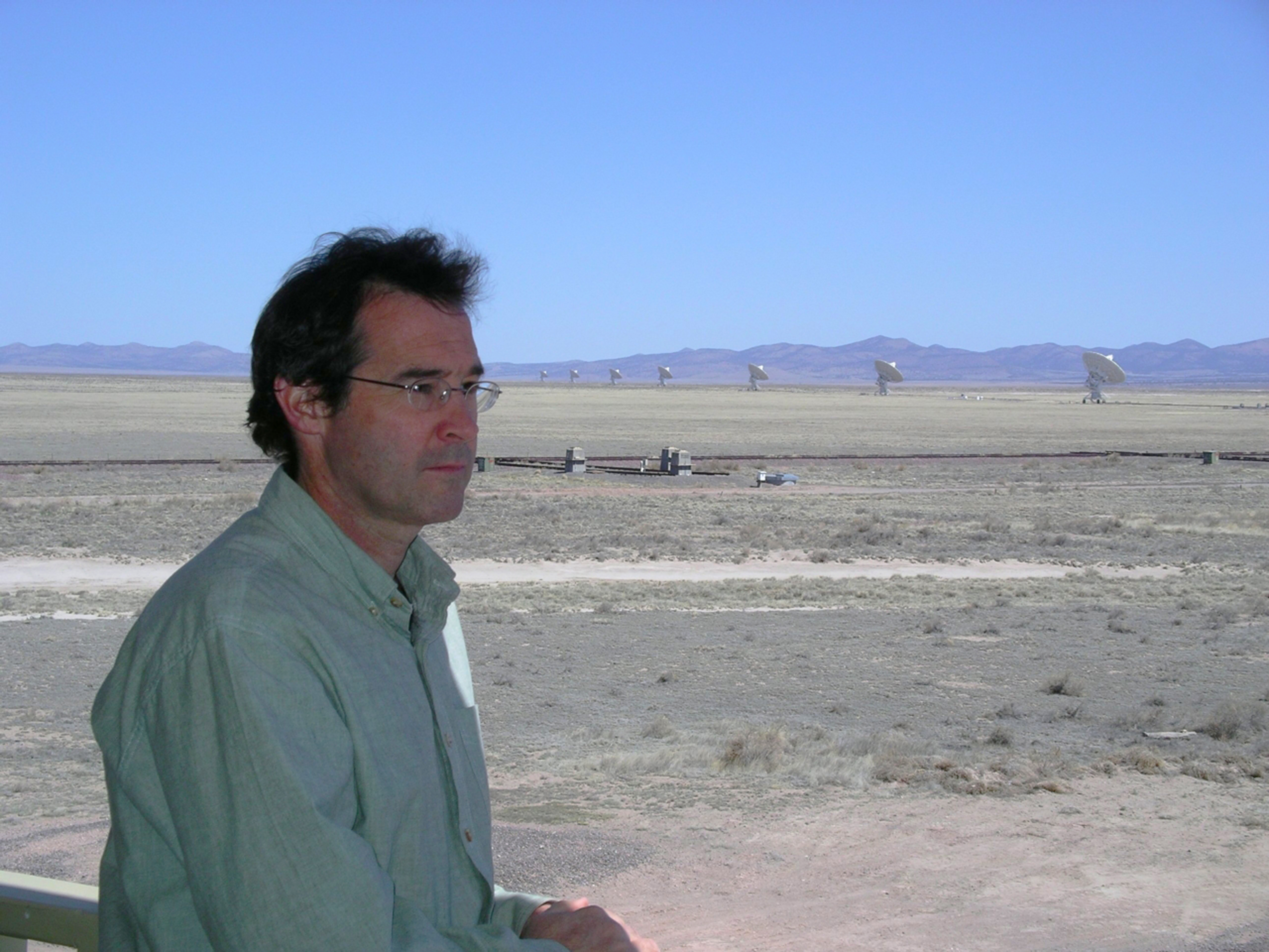Career of the Month
Career of the Month: Astronomer
The Science Teacher—September/October 2022 (Volume 90, Issue 1)
By Luba Vangelova
Astronomers study objects that are outside of the Earth’s realm, such as stars, planets, comets, and galaxies. Chris Carilli is an astronomer at the National Radio Astronomy Observatory (NRAO), which operates the National Science Foundation’s Karl G. Jansky Very Large Array (VLA) in Socorro, NM. The VLA is a conglomeration of large radio antennas arranged in a miles-long Y formation, which together function like one large telescope. Carilli studies the birth and formation of massive galaxies and cosmic reionization (the period in the history of the universe when stars and galaxies first appeared), by analyzing the very low-frequency (radio spectrum, and therefore invisible to the human eye) light waves emitted by all celestial matter.

Work Overview
My days are split equally between my two primary duties: supporting the observatory in its service work, and performing basic research. My support work involves representing the NRAO to the community and to government agencies such as the NSF; serving on committees that deal with staff promotions and hiring; and, most of all, working closely with the team that is responsible for the technical design of the NRAO’s future flagship facility, the Next Generation Very Large Array.
My research focuses on galaxy formation. In particular, I use radio techniques to study the gas and dust that existed in early galaxies, and I conduct experiments designed to detect large-scale structures in the very early stages of the universe, using low-frequency radio waves. This is effective because different types of matter emit distinctive wave patterns. Most recently, I have been developing new methods for interferometric imaging—the merging of light collected from multiple antennas to create a sharper image than one antenna could achieve on its own—based on the basic principles of Fourier optics. More concretely, my research work entails setting up observations and analyzing the data, then interpreting it and communicating the results via publications and lectures.
My work used to require a lot of travel. For seven years, I had a 20-percent-level research director position at the Cavendish Lab in Cambridge, UK. Although it was a great experience overall, the travel wore me out. Since spring of 2020, my work travel in general has pretty much stopped.
The romance of physically going to an observatory to look through a telescope is over. Now it’s all queues, dynamic scheduling, and remote data access. But what continues to make me eager to get to work each day is the prospect of discovery. There’s nothing quite like learning something really new every day. It may just be new to me, and that is great in itself. Or it may be new to everyone, which is the ultimate goal.
Career Highlights
My career highlights center on discovery—those moments when you see something in your data that no one has seen before, and whose physical importance you understand. Or when you’ve found the answer to a difficult problem that maybe no one has ever solved. This usually happens when I am swimming in the morning.
One interesting result was the first discovery of molecular gas in the very early universe, 800 million years after the Big Bang. This was a big jump from the previous most distant detection, and showed that heavy elements and molecules can form very early in the universe and fuel galaxy formation.
Career Path
I have wanted to be an astrophysicist for as long as I can remember. I don’t think I could do anything else. A major influence was watching Star Trek when I was young; I wanted to be Spock. After high school, I went to university and studied physics and astronomy. I then continued on to graduate school. I transferred to MIT’s Radio Group from the University of Chicago, because I went to a talk about the Very Large Array, which had just opened, and I decided that my career goal would be to figure out how it worked.
Aside from some postdoctoral positions right after graduate school, I have worked primarily at NRAO for the past 30-plus years.
Knowledge, Skills and Training Required
You need to have a solid grasp of mathematics, basic physics, and computing. If your interests lie in radio astronomy, you also need to know some radio engineering. I am a big fan of gaining basic knowledge; those are the building blocks of everything else. The details of a specific field can always be learned on the job. The real goal of advanced education is to learn how to learn, and to get the skills needed to advance in a career.
A PhD is required for physicists and astronomers who apply for our scientific staff positions, and also for university professors. Post-doctoral fellowships are also the norm if you want to go down an academic route. For engineers, a master’s degree may be adequate, depending on the position.
Right now, the discovery of exoplanets, and the search for life outside the Earth, is probably the most interesting thing we are doing. If and when we do discover extraterrestrial life, I reckon there will be a sea change in the field.
Advice for Students
This is a competitive field, so gain as many marketable skills as you can. College internships can help with that; they can also give you a different perspective than coursework.
Don’t expect astronomy to be all romance. Don’t expect discovery and knowledge to come easily. And don’t get discouraged. This job is up to 110 percent perspiration. Also don’t look down on jobs in industry. There is a lot of fascinating work being done across industries, from computing to manufacturing, and everything in between. The work emphasis may be a bit different (immediate product vs. polished paper), but the research can be just as challenging and rewarding.
Bonus points
Carilli’s Education: BA in physics and astronomy, University of Pennsylvania; PhD in physics, MIT
On the Web: https://public.nrao.edu/radio-astronomy/the-science-of-radio-astronomy/
Related Careers: Planetary scientist and ionospheric physicist


